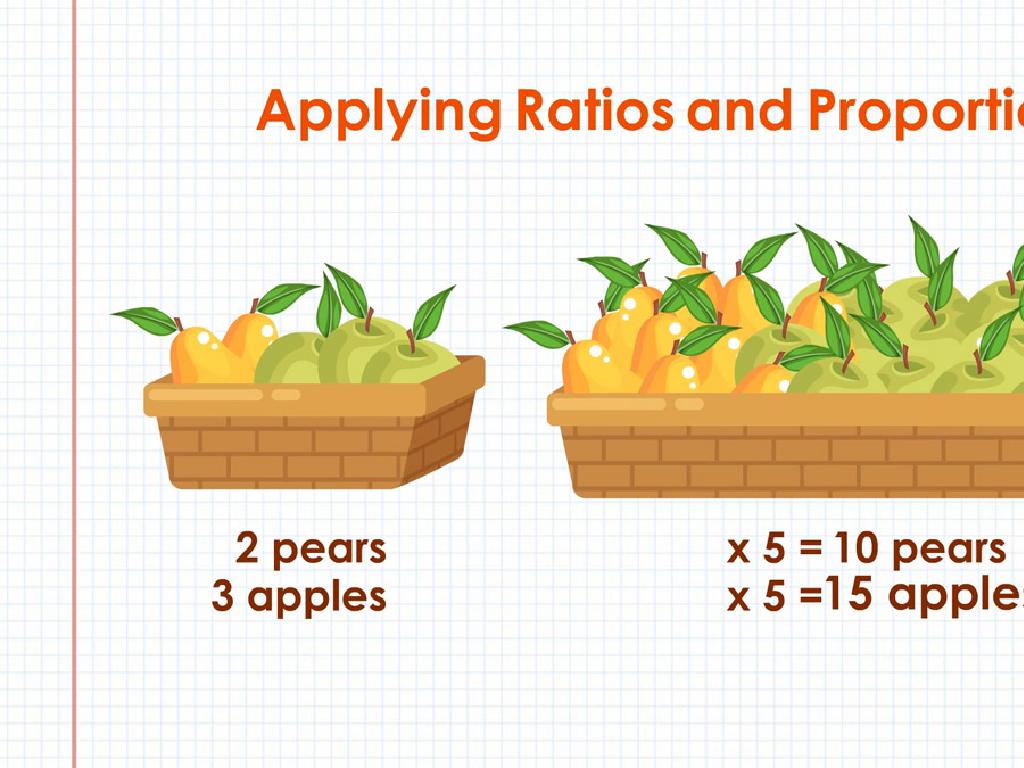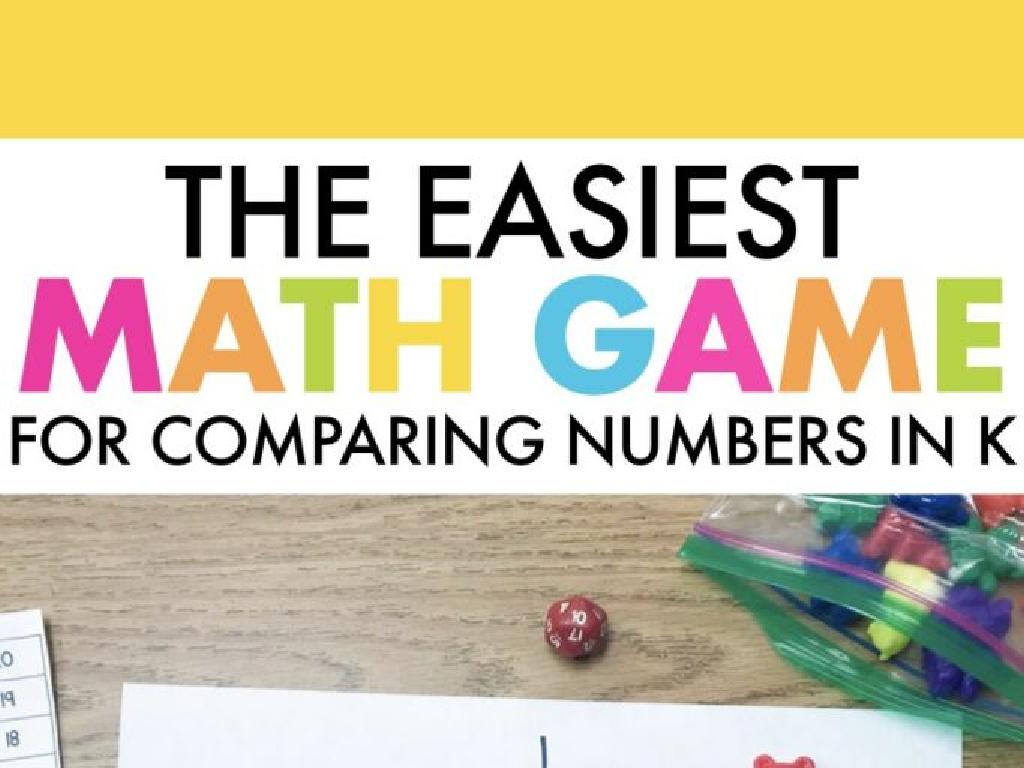Addition Facts - Sums Up To 10
Subject: Math
Grade: First grade
Topic: Addition Up To 10
Please LOG IN to download the presentation. Access is available to registered users only.
View More Content
Welcome to Addition!
– Learning to add numbers up to 10
– Addition means putting numbers together
– Like combining 2 apples and 3 apples to have 5 apples in total
– Using pictures to understand addition
– Visual aids help us see the total as we add
– Storytelling to make addition fun
– We’ll use stories where characters come together, like 3 bears joining 2 more
|
This slide introduces first graders to the concept of addition as a means of finding the total number of items when combined. Emphasize that addition is simply putting together different amounts and counting the result. Use visual aids like pictures of objects that students can relate to, such as fruits, toys, or animals, to illustrate the concept of combining groups. Incorporate storytelling into the lesson to engage the students and help them visualize the process of addition in a narrative context. For example, use a story where a few animals are having a party and more animals join in, and then count all the animals together. This approach will help students grasp the concept of addition in a fun and memorable way.
Learning Addition: Sums Up to 10
– Addition combines groups
– Putting two or more groups together makes a bigger group.
– Add with toys, fruits, fingers
– Use objects like 3 apples + 2 apples, or count 4 fingers + 1 finger.
– Adding finds total amount
– If you have 2 balloons and get 3 more, how many do you have now?
– Practice sums up to 10
– Let’s add numbers from 1 to 10 and see what we get!
|
This slide introduces the concept of addition to first graders by relating it to everyday objects and scenarios. Start by explaining that addition is a way of finding out the total number of items in combined groups. Use relatable examples like adding toys or fruits, which they can visualize and understand easily. Emphasize that addition helps us know how many things we have in total. Encourage the students to use their fingers to add numbers up to 10, as this tactile method can help solidify the concept. Provide simple practice problems and use visual aids like counting blocks or pictures to help them grasp the idea of combining groups to find a sum.
Understanding Addition Symbols
– The ‘+’ sign means to add
– When we put numbers together, we use ‘+’
– The ‘=’ sign means ‘equals’
– When two things are the same, we use ‘=’
– Writing addition sentences
– 2 + 3 = 5 is an addition sentence
– Examples of addition facts
– Like 1 + 1 = 2, 2 + 3 = 5, up to 10
|
This slide introduces the basic symbols used in addition for first graders. The ‘+’ sign is used to indicate that two or more numbers should be combined, while the ‘=’ sign shows that the numbers on either side of it are equal in value. It’s important to use clear and simple language to explain these concepts, as well as providing relatable examples. Encourage the students to think of addition as combining groups of objects, like adding more blocks to a pile. Practice writing addition sentences together and use visual aids like counting fingers or drawing objects to help them understand the concept of summing up to 10.
Let’s Add Together!
– Adding with real objects
– Example: 2 + 3 apples
– We start with 2 apples, add 3 more, and count all to get 5.
– Combining groups makes a new total
– When we add, we’re putting two amounts together to find out how many we have now.
– Practice with visible items
– Use toys or blocks to add numbers up to 10.
|
This slide is designed to introduce first graders to the concept of addition by using tangible objects like apples. Start by showing the example provided, using actual apples or a picture to visually demonstrate the addition of 2 apples plus 3 apples equals 5 apples. Emphasize that addition is simply combining two groups to find out the total amount. Encourage the students to practice with objects they can see and touch, such as toys or blocks, to reinforce the concept. This hands-on activity will help them understand that addition is about combining quantities to make a new total. Make sure to walk around the classroom to assist and ensure that each student is grasping the concept.
Addition Facts to 5
– Use a number line for addition
– A number line helps us count steps to add
– Practice sums up to 5
– Find pairs of numbers that add up to 5 or less
– Example: 1+1 equals 2
– Adding 1 plus 1 gives us 2
– Example: 2+2 equals 4
– Adding 2 plus 2 gives us 4
|
This slide introduces students to the concept of using a number line as a visual aid for understanding addition. Start by explaining that a number line can show how two numbers come together to make a sum. Demonstrate with simple examples like 1+1 and 2+2, and show how to count the steps on the number line. Encourage students to practice with different number pairs that add up to 5 or less. Use hands-on activities like counting objects or using fingers to reinforce the concept. The goal is for students to become comfortable with basic addition facts up to 5.
Addition Facts: Sums Up to 10
– Adding numbers to make 10
– Use fingers for counting
– Counting on fingers helps us add!
– Example: 4 + 3 equals 7
– 4 fingers plus 3 fingers make 7 fingers
– Example: 5 + 2 equals 7
– 5 fingers plus 2 fingers make 7 fingers
|
This slide introduces students to the concept of addition with sums that go up to 10. Encourage the students to use their fingers to count, as this is a practical and visual way to understand addition. Start with simple examples like 4+3 and 5+2, and demonstrate these on your own fingers. Ask the students to try a few examples themselves, using their fingers to add up to 10. Reinforce the idea that different number pairs can add up to the same sum, and this is a fun part of learning addition. For homework, they can practice with other pairs of numbers that add up to 10 and come back to share their findings.
Adding with Stories: Crayon Tales
– Stories make addition fun
– Start with 4 crayons
– Imagine your colorful crayons
– Friend gives you 3 more
– Picture getting more from a friend
– How many crayons now?
– Count them all together for the total
|
This slide introduces the concept of using storytelling to make learning addition more engaging for first graders. Start by asking students to visualize their own set of crayons, which makes the math problem relatable and tangible. Encourage them to imagine the scenario where they receive additional crayons from a friend, and then use their counting skills to find the total. This method helps to contextualize the abstract concept of addition, making it easier for young learners to grasp. During the class, you can ask students to come up with their own stories and solve addition problems within them. This interactive approach promotes creativity while reinforcing their arithmetic skills.
Class Activity: Addition Bingo
– Let’s play Addition Bingo!
– Solve addition problems
– Use sums up to 10 to find answers
– Cover the answer on your card
– Use counters or markers on your card
– Shout ‘Bingo!’ for a full row
– Be the first to get a full row covered
|
This interactive game is designed to help first graders practice addition facts with sums up to 10 in a fun and engaging way. Prepare bingo cards with numbers up to 10 in advance. During the activity, call out addition problems for the students to solve. Students will use counters or markers to cover the correct answers on their bingo cards. The goal is to cover a full row horizontally, vertically, or diagonally. When a student gets a full row, they shout ‘Bingo!’ and the class will pause to check their answers. This activity encourages quick mental addition and provides a way to assess students’ understanding in a group setting. Offer a small reward or praise to make the game exciting. Have multiple rounds to give each student a chance to win.
Addition Facts Review and Practice
– Reviewing addition concepts
– Let’s recall how to put numbers together to add up to 10.
– Practice addition at home
– Try adding numbers using toys or snacks.
– Use tools to help add
– Objects, stories, fingers can make addition easier.
– Keep practicing for perfection
|
This slide is aimed at reinforcing the addition facts that students have learned. Start by reviewing the concept of addition as combining two or more numbers to get a total sum. Encourage students to practice their addition skills at home using everyday items like toys or snacks to make learning more interactive and fun. Remind them that they can use different methods such as counting objects, visualizing a story, or using their fingers to help them understand and remember addition facts. The goal is to make them comfortable with addition up to 10 through repetition and to use practical tools that they can easily access.
Congratulations, Addition Experts!
– Celebrate learning addition up to 10
– You are now addition whizzes!
– Looking ahead to subtraction
– Next class, we’ll explore taking numbers apart
– Keep practicing your addition skills!
– Try more addition problems at home to become even faster!
|
This slide is meant to congratulate the students on their hard work and mastery of addition facts up to 10. It’s important to celebrate their achievement to build confidence. Reinforce the idea that they are now ‘addition experts’ and encourage them to continue practicing. Introduce the concept of subtraction as the next step in their mathematical journey, framing it as an exciting new challenge. Provide encouragement for them to keep practicing addition at home to maintain and improve their skills. The next lesson will build on their addition knowledge by introducing subtraction, helping them understand the relationship between the two operations.






